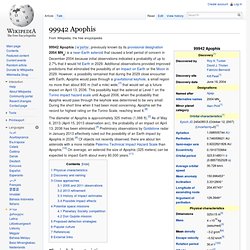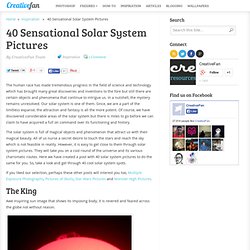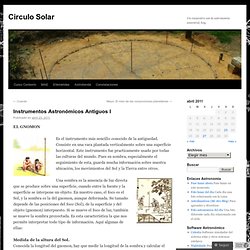

99942 Apophis. 99942 Apophis (/əˈpɒfɪs/, previously known by its provisional designation 2004 MN4) is a near-Earth asteroid that caused a brief period of concern in December 2004 because initial observations indicated a probability of up to 2.7% that it would hit Earth in 2029.

Additional observations provided improved predictions that eliminated the possibility of an impact on Earth or the Moon in 2029. However, a possibility remained that during the 2029 close encounter with Earth, Apophis would pass through a gravitational keyhole, a small region no more than about 800 m (half a mile) wide,[7] that would set up a future impact on April 13, 2036. This possibility kept the asteroid at Level 1 on the Torino impact hazard scale until August 2006, when the probability that Apophis would pass through the keyhole was determined to be very small. During the short time when it had been most concerning, Apophis set the record for highest rating on the Torino Scale, reaching level 4.[8] Close approaches[edit] Spacevidcast ›› For the space geek in all of usSpacevidcast » For the space geek in all of us. Astro Anarchy. Hubble's Panoramic View of a Star-Forming Region. The First Book of Space Travel. We've been traveling all over the US this month, but now it's time to aim a little higher with our eyes on the future-- and I mean the future of 1953 and OUTER SPACE!

Written and illustrated by Jeanne Bendick, with a Space Consultant assist from Hal Goodwin, The First Book of Space Travel(Franklin Watts, 1953) is a truly awesome 60+ page book full of everything you'll ever need to know about journeying to the final frontier and beyond. The select illustrative highlights here only begin to scratch the surface, and in some cases, I left in excerpts of fun text, further revealing how essential this book is for those of you planning a life someday among the stars! Is Mercury in Retrograde?:
Analemna. Cwl. 1910 eclipse and phases of the moon print by antiqueprintstore. 100,000 Stars. 40 Sensational Solar System Pictures. The human race has made tremendous progress in the field of science and technology which has brought many great discoveries and inventions to the fore but still there are certain objects and phenomena that continue to intrigue us.

In a nutshell, the mystery remains unresolved. Our solar system is one of them. Since, we are a part of the limitless expanse, the attraction and fantasy is all the more potent. Of course, we have discovered considerable areas of the solar system but there is miles to go before we can claim to have acquired a full on command over its functioning and history.
The solar system is full of magical objects and phenomenon that attract us with their magical beauty. If you liked our selection, perhaps these other posts will interest you too, Multiple Exposure Photographs, Pictures of Skulls, Star Wars Pictures and Monster High Pictures. The King Awe inspiring sun image that shows its imposing body; it is revered and feared across the globe not without reason. The King. Instrumentos Astronómicos Antiguos I. Es el instrumento más sencillo conocido de la antiguedad.

Consiste en una vara plantada verticalmente sobre una superficie horizontal. Este instrumento fue practicamente usado por todas las culturas del mundo. Pues su sombra, especialmente el seguimiento de esta, guarda mucha información sobre nuestra ubicación, los movimientos del Sol y la Tierra entre otros. Turismo Astronómico en Chile. Photopic Sky Survey.
Solar System Scope. Earth View. Photopic Sky Survey. Cara oculta de la Luna. Fotografía de la cara oculta de la Luna. Estampilla de la URSS de 1959 conmemorando la primera fotografía de la cara oculta de la Luna. La cara oculta de la Luna es el hemisferio de la Luna no observable desde la Tierra. Eso ocurre debido a que la Luna tarda en rotar sobre sí misma lo mismo que su movimiento de traslación alrededor de la Tierra.
Debido a las libraciones, desde la Tierra sólo se nos oculta el 41% de la superficie lunar (es decir unos 15,5 millones de km²), que es imposible observar desde nuestro planeta. Historia[editar] Este hemisferio estuvo oculto a la vista humana hasta que la sonda automática soviética Luna 3 lo fotografió por primera vez el día 7 de octubre de 1959.[1] Como la Luna tarda el mismo tiempo en dar una vuelta sobre sí misma que en torno a la Tierra, presenta siempre la misma cara.
La banda inglesa Pink Floyd le hizo un homenaje en su disco The Dark Side of the Moon Geografía[editar] Se trata de una zona mucho más accidentada que el hemisferio visible. Solar system.